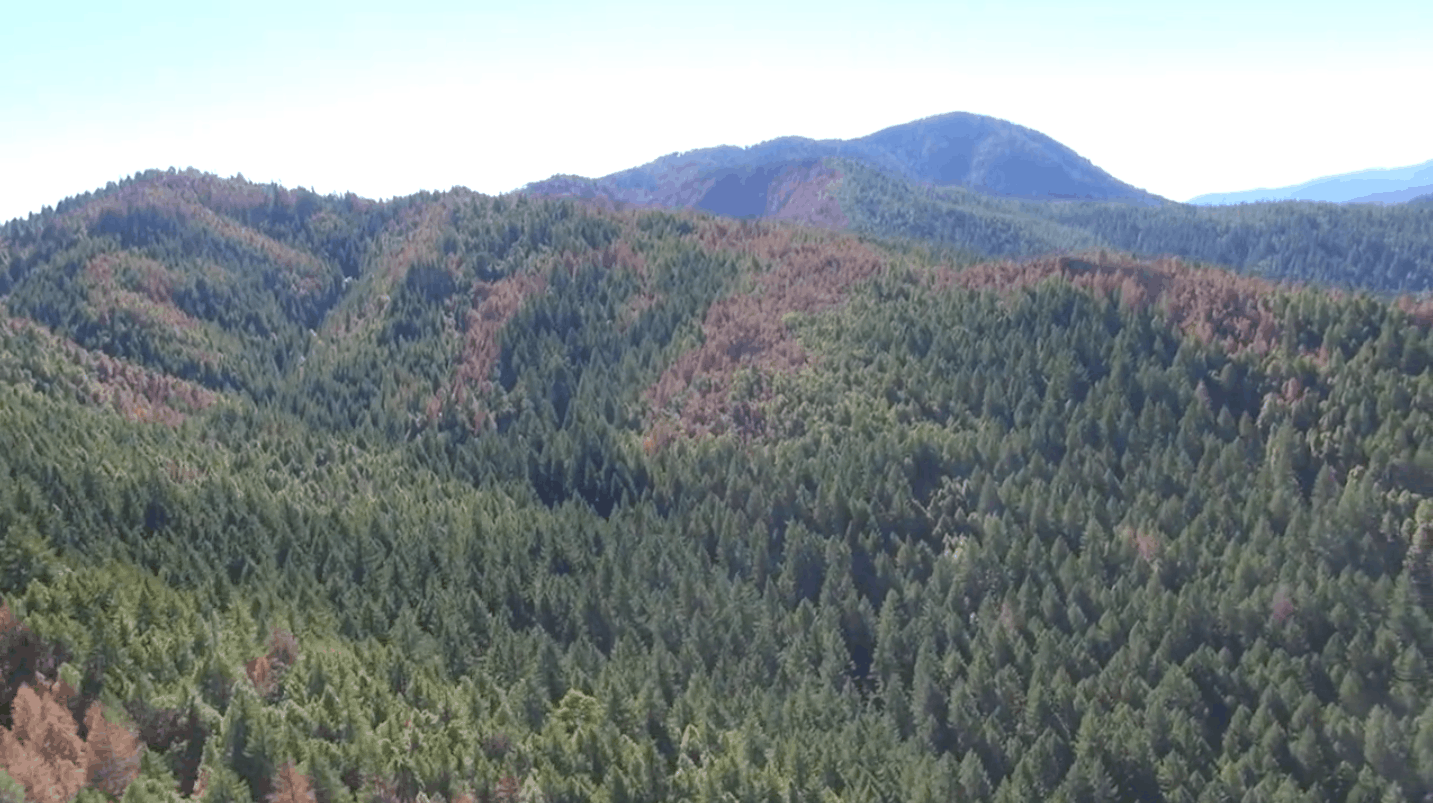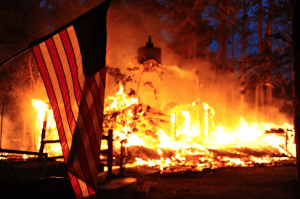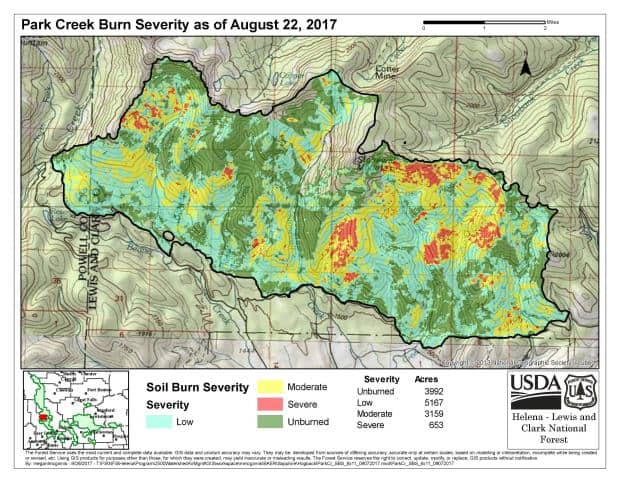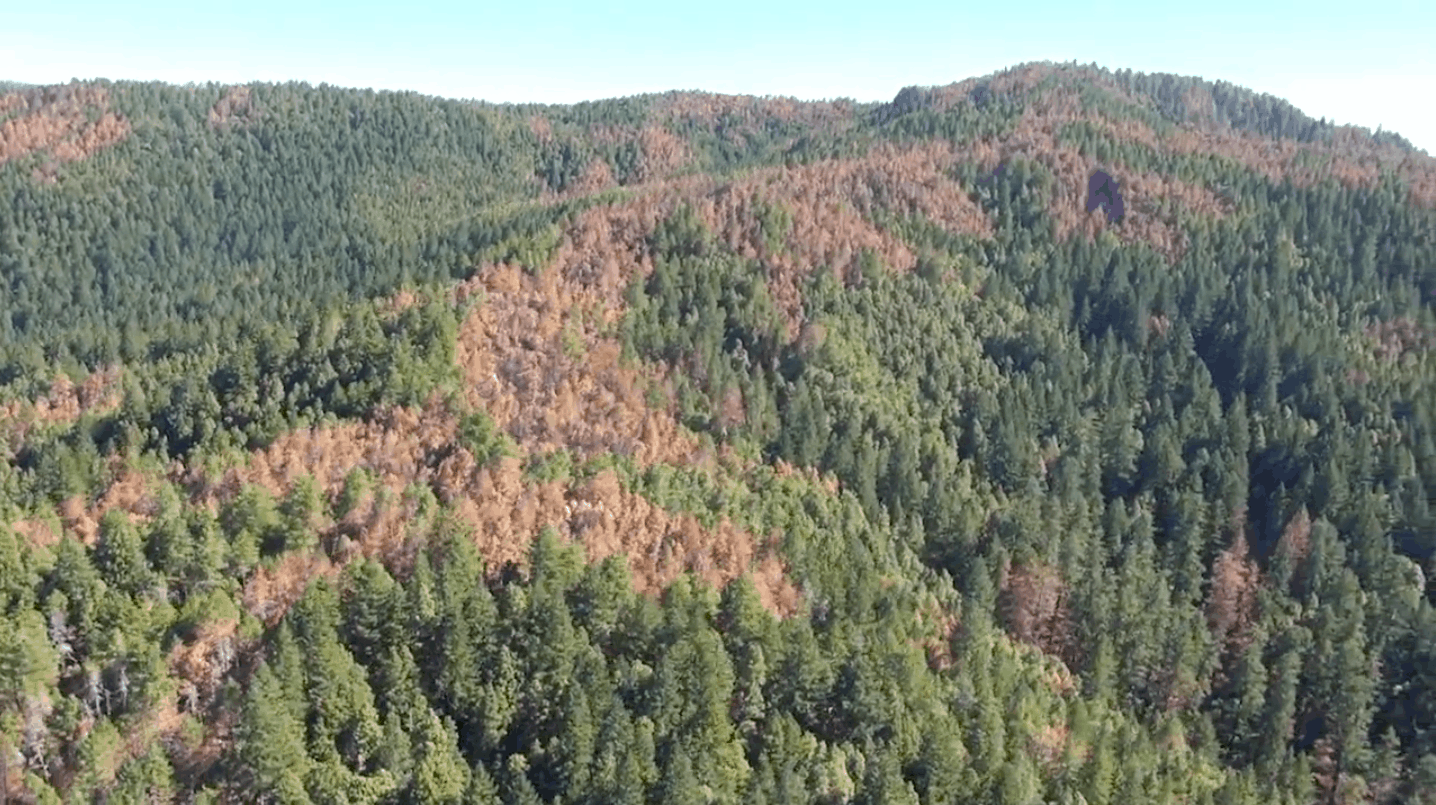Hispanic Heritage Month began on September 15 and ended yesterday. Or so says the U.S. Forest Service’s homepage. However, unlike the other four banner ads, which click through to provide information on Fall Colors, wildfires, and the like, the Hispanic Heritage Month banner ad links to nothing. The Wayback Machine says that the Forest Service’s Hispanic Heritage dead link first showed up on its homepage on October 10, five days before the month-long observance’s end. For those who wish to know about National Hispanic Heritage Month, click on this link.
ClimateWire – What we know about wildfires and climate change
Pretty good article (posted here as a PDF) that presents a range of research on the relationship of wildfires and climate change. The author might have added more about other factors, such as fuels management, but did add this paragraph near the end of the article:
“Additionally, wildfires, perhaps more than any other type of natural disaster, are heavily subject to the influence of human land use — the types of vegetation we plant or clear away, how often we allow it to burn, and how we choose to manage fires once they start. These types of decisions could both mitigate or exacerbate the intensity of future fire seasons, the effects of climate change notwithstanding.”
Fuels management can be a big help in dealing with wildfires
Dr. Daniel M. Leavell has extensive experience in regard to wildfires that, I imagine, few with a doctorate could claim. His qualifications to speak on this subject are summarized in this quote from his 2017 CV: “I have been involved with fire behavior and disturbance ecology since March of 1973. My experience with wildland firefighting from 1978 to 2012 included being qualified and having had experience as firefighter, squadboss, crewboss, helitac support crewmember, division group supervisor, safety officer, situation unit leader, infrared interpreter, field observer, Incident Commander Type 3, and Operations Section Chief for Type 1 and 2 incident management teams. I have been a member of several Type 1 and Type 2 incident management teams (including wildland fire use teams) for the Northern Rockies. I was responsible for all operations, tactics (short – and long – term), and personnel on fire incidents. I directly supervised all ground and air personnel, information (including advanced fire behavior predictions), and resources. I ordered and directed these resources to meet objectives in a safe and cost effective manner. I have had 30+ years of firefighting experience in complex and diverse fuel types and terrain throughout the Pacific Northwest, Rocky Mountains, Southwest, Southeast, and Alaska and have been cited for excellent leadership and the ability to strategize and direct all resources for immediate, efficient, and effective attainment of objectives. I have served on fires ranging in size from 5 to over 100,000 acres, and have managed and been directly responsible for thousands of human and mechanical resources. And after serving on over 300 fires (including several hurricane relief efforts), only two people I have been responsible for have had minor reported injuries and no fatalities. I am very glad and proud of that and have worked hard to achieve that claim.” (Italics added)
Here are some of the points he makes in regard to the value of forest management in dealing with wildfires:
1) “Dead forest vegetation has been accumulating, drying and remaining cured longer”
2) “The size of forest fuels also greatly influences fire behavior. A quarter-inch diameter twig dries sooner, ignites faster and burns quicker than a 30-inch diameter log because small-diameter wood has more surface area than larger material.”
–> Clarification: “small-diameter wood has more surface area than larger material.” should read: ‘small-diameter wood has more surface area per unit of volume than larger material.’. All else being equal, the higher the surface area per unit of volume the greater the chance of an explosive ignition from a spark (i.e. needles versus logs, shavings vs. lumber and flour vs. seed). In addition, such down wind high surface area per unit of volume materials will dry out more quickly from the heat produced by advancing flames especially if the fuel is above the ground rather than resting on or in the ground.
3) “The drier the wood with more oxygen applied (wind), the hotter it will burn”
4) “Hazards have dramatically increased and exposed our firefighters to more risks. Firefighter safety is always the primary objective and no fire is worth risking a life. For that reason, there is less direct attack on fires than before.”
5) “It has always been easier and safer to suppress fires in responsibly managed forests, where ecosystem health, fuels reduction, wildlife habitat and overall diversity are the primary objectives. This is true today.”
6) “Firefighters use the term red flag conditions to describe when lower humidity, and higher temperatures and winds reduce fuel moisture content. Anything organic can then burn hot if an ignition source starts a fire. Will removing the biomass of live and dead woody fuel affect fire intensity and severity? Of course, it can. The less fuel to burn, the lower fire intensity”
7) “Fuels management is one of the few things we can do along with suppressing fires. We are good at both. Terrain is normally out of our control, as is weather. But, we can manage forest fuels.”
8) “Managing fuels through responsible forest management reduces wildland fire risks, hazards, intensity and severity. It also improves overall forest health and wildlife habitat.”
9) “We have opportunities and choices to make. We can manage our forests responsibly by easing fire back into fire-adapted ecosystems through careful harvests, controlled burns, and various tools in our management toolboxes. Fire and resource management agencies across the West are examining various suppression strategies as an over-abundance of forest vegetation, climate change and more homes (which are fuels, too) in fire-prone areas make massive fires increasingly common and dangerous to residents and firefighters”
10) “We can use science to manage fires to increase firefighter and public safety, foster forest health, promote fire resiliency and nurture wildlife habitat — while improving economic opportunities that will bring jobs. Or, we can let it burn hot and let it go up in smoke”
11) “We can never stop all wildland fires through responsible forest management or otherwise.”
12) “responsible forest management reduces wildland fire risks and hazards. It also reduces fire intensity and severity when they burn in fire-adapted, fire-prone environments.”
–> Clarification: reduced fire intensity and severity make a fire easier/quicker/less costly to extinguish.
Can we all agree that this expert is correct in stating that these are facts (well established fire/forest science) as supported by many other posts and comments on this blog site and elsewhere which have been drawn from scientific journals of old to modern day on-line publications/reports?
If so, can we move on to a discussion of how this should drive our forest policy?
Note: The two –> clarifications are mine.
September litigation monthy
This gets us up-to-date with the weeklies I’ve received. Sit back, have a cup of coffee ….
- Cent Or Landwatch v Connaughton – The Deschutes decision to authorize a water supply intake was consistent with the forest plan riparian management objectives (RMOs) and complied with NEPA. (9th Circuit)
- Beaver Creek NOI – Alleged violations of ESA on the Flathead for failing to consult on the forest plan for grizzly bears in newly acquired lands, and for proceeding with a project in lynx critical habitat prior to completion of forest plan consultation.
- Boise NOI, Payette NOI, BridgerTeton NOI – Alleged violations of ESA consultation/conference requirements for publication of over snow vehicle use maps.
- Friends Wild Swan v. Kehr – (New case.) The Beaver Creek Project on the Flathead is being challenged for failure to consider the cumulative effects of another project on the same ranger district, and for being inconsistent with forest plan road density standards for grizzly bears and elk. (See also Beaver Creek NOI above.) (D. Montana)
- Oregon Hunters Association v USFS – (New case.) Plaintiffs argue that the Ochoco Summit Trail System Project on the Ochoco failed to consider effects on elk and violates the forest plan direction for elk. (D. Oregon)
- CCRMC_v_USFS – Collection of data related to possible construction of a mine tailings pond on the Tonto had nominal effects on the environment, and approval did not require consideration of the impacts of the proposed copper mine it would service. (D. Arizona)
- WinterWildlandsAlliance_v_USFS – (New case.) This case involves over snow vehicle use maps on the Boise, Payette and Bridger-Teton prepared in 1988 and 1990. They are alleged to based on out of date information, violate forest plan requirements for at-risk species, and were not eligible to be “grandfathered in” under the Travel Management Rule. There is also a claim under the Wyoming Wilderness Act. (See also ESA NOIs above.) (D. Idaho)
- WesternWatersheds_v_Michael – A Wyoming state statute that criminalized collecting data on public lands after trespassing on private lands infringed on the First Amendment’s right of free speech. (10th Circuit)
- Rocky Mtn Wild v Dallas – In a case that voided the Rio Grande’s approval of land exchange related to the Wolf Creek Ski Area, the court denied a motion by the proponent to reconsider its decision. (D. Colorado) Discussed in more detail here.
- Sequoia Forestkeeper v Price – The Frog Timber Sale Project on the Sequoia complied with NEPA and forest plan requirements with regard to fisher. (E. D. California)
- FSEEE v USFS – (New case.) The complaint alleges that the decision to grant a special use permit to the Navy to conduct electronic warfare training did not to comply with the Olympic forest plan. W.D. Washington)
- CBD v BLM – (New case.) The Battle Mountain District of the BLM (Nevada) leased 195,732 acres for oil and gas development using an EA, and was challenged regarding its NEPA compliance. (D. Nevada)
- DOW v Duke – (New case.) This case involves the decision by the Department of Homeland Security to waive federal laws under the Illegal Immigration Reform and Immigrant Responsibility Act to construct a prototype Mexican border wall, due to its environmental impacts. (S.D. California)
- WildEarth Guard v BLM – The BLM failed to adequately consider the greenhouse gas emissions of four coal leases in Wyoming because its assumption that coal would be produced elsewhere if the no-action alternative were selected was not supported by the record (though mining was allowed to continue on remand). (10th Circuit)
- WildEarthGuardians v. Provencio – The Kaibab’s use of the motorized big game retrieval exception under the Travel Management Rule complied with the Rule and the National Historic Preservation Act, and the EA complied with NEPA. (D. Arizona)
- USA v. Carpenter – Elko County did not prove ownership of a road on the Humboldt-Toiyabe, and the Forest could not convey rights to the road in a settlement agreement. (D. Nevada)
- Alaska v. USDA The 2001 Roadless Area Conservation Rule was again upheld, including consideration of its application to the Tongass. (D. D.C., scanned file size exceeds site capacity)
- CBD v. FWS – (New case.) Plaintiffs challenge the biological opinion by the Fish and Wildlife Service, and reliance on it by the Coronado when it approved the operating plan for the Rosemont Copper Mine. (D. Arizona) Discussed further here.
- Wyoming v. Zinke – The BLM has proposed to rescind its 2015 Fracking Regulation, and therefore a case involving its validity was not ripe for judicial review. (10th Circuit)
Science Article on Jerry Franklin, Early Seral and the PNW Plan

I’m still on vacation, but saw this and thought it worth posting.. thanks to Forest Business Network.
This article is about the need for early seral in the PNW, but not clear on how much and exactly why. That seems to be why people disagree about how and where. This reminds me of what FS folks used to say about HRV.. it’s a reference, not a prescription. Which leaves lots of room for disagreement about how to use the reference :)!
Good on Jerry for still being there, still thinking and using his wisdom and experience to learn more about forests. He was a teacher and willing to come to the Ochoco to help us out when I was a young sprout and he’s still going strong, and still making a difference. Pretty much a role model for all of us older folks.
Now, Franklin is pressing his case in another major arena: a review of the mammoth Northwest Forest Plan. Nearly a quarter-century after he helped give birth to the plan, federal scientists are re-evaluating the supporting research in a first step toward revising the plan.
DellaSala sees no need for major changes to a plan that he, like many, regards as a landmark. “It’s not that the Northwest Forest Plan is broken,” he says. But Franklin, who served as a reviewer for a draft of the scientific report, is urging a rethink. If he has his way, federal agencies will create more early seral habitat by logging some of the hundreds of thousands of hectares of dense forest replanted after clearcutting, and then letting it regrow on its own.
Here’s the link.
California Fires Ravage Private, Industrially Managed Landscape
Add together the structures lost to every national forest wildland fire this year and their sum would be a rounding error compared to the more than 1,500 2,000 3,500 5,700 7,000 8,400 homes and businesses lost in the on-going Napa Valley fires.
Radical environmentalists are being blamed for the devastation: “White wine-swilling San Francisco liberal elites created the conditions that fueled these catastrophic fires,” explained a House Natural Resources committee spokesman.
Nearby federal wilderness areas remain unaffected.
[Satire alert!]
Forest Service releases soil burn severity maps for some Montana wildfires
The U.S. Forest Service has just started releasing detailed soil burn severity maps for wildfires that burned in the Northern Rockies this year. Hopefully some of this information and these maps are shared by the news media and political leaders.
Individual maps of some specific fires are here.
What’s the take home message from these soil burn severity maps? Looks like the 2017 wildfires burned in a mosaic pattern with lots of unburned, very low, and low to moderate soil burn severity.
SOME EXAMPLES FROM SPECIFIC WILDFIRES:
Only 3% of the acres burned in 45,000 acre Sapphire Complex Wildfires on Lolo National Forest had soil burn severity measured as “High.” Meanwhile, 78% of acres in Sapphire Complex Wildfires on the Lolo NF had soil burn severity measured as “Unburned” “Very Low” or “Low.”
The vast majority of the lightening-caused Park Creek fire was either unburned, or burned at low to moderate severity. Senator Daines, Rep Gianforte and the Montana timber industry – especially Ed Regan, resource manager for RY Timber – blamed this wildfire on a lawsuit by the Alliance for the Wild Rockies. The soil burn severity map for the Park Creek fire is below. Ed Regan complained that the wildfire was going to “destroy” the forest and wildlife habitat. Sorry to disappoint you Ed, but it doesn’t look that way!
Meanwhile, when Interior Secretary Ryan Zinke, Ag Secretary Sonny Perdue, Rep Gianforte and Senator Steve Daines toured the Lolo Creek Fire on the Lolo and Bitterroot National Forest – they blamed wildfires on “environmental extremists.” This was despite the fact that there was NEVER ANY lawsuit filed to stop any logging project near the Lolo Peak Fire. Turns out that 66% of the Lolo Peak Fire acres had “unburned” “very low” or “low” soil burn severity, while only 9% had “high.”
More fire severity maps will be posted by the U.S. Forest Service as they become available, so make sure to check back at this link.
Also, two weeks ago I contacted U.S. Forest Service Burned Area Reflectance Classification (BARC) data-producing team to get a satellite-derived data layer of post-fire vegetation condition for Montana wildfires. I was told the U.S. Forest Service no longer releases initial BARC data to the public for “political reasons.” So we will have to patiently wait for that information.
Frustration: Will It Lead to Change?
In Eastern Oregon some have the impression that “a breath of fresh air is blowing across the landscape of forestry issues in Eastern Oregon”
Some Key Points from the Wallowa County Chieftain:
1) ““I don’t think Oregonians want their forests destroyed by runaway fires every summer and their air-sheds choked to the point that they can’t breathe,” Walden said. “I think we have real momentum to do good public policy.””
2) “Commissioners have long been frustrated when agreements reached with the U.S. Forest Service are discarded by other agencies that were not present when discussions took place.”
3) “the last few weeks have seen an abrupt change in the attitude of forest managers. Commissioners reported that in August, Penya was uninterested in their issues and let them know that conversations were over and USFS was moving forward with forest plans re-written by agencies.
Just two weeks later, commissioners reported, Penya seemed in the mood to negotiate.
“He called me and asked me about my opinion on how to do things,” said McClure. “He asked me — that’s a real change in status. He is really concerned about moving this thing forward. I brought up the issue on grazing. I was going to ask him for half a billion board feet for Boise Cascade before it was over … he was pushing hard to see that something got done.””
4) USFS Chief ““Tooke is all about getting in after these fires and all about trying make these systems work,””
5) ““It’s a different attitude now (with agencies, such as USFS, NIMS, U.S. Fish and Wildlife). It’s about how can we help. I feel like for the first time there is a new opportunity to really have an impact with these agencies.””
Only time will tell.
Take a Flyover of the Chetco Bar Fire

How cool is this? I’ve been meaning to post this for the past week.
From the comfort of your own computer screen you can take a flyover of the 191,000 acre Chetco Bar Fire in southwestern Oregon with the National incident Team!
The thing that strikes me right away is the very clear mosaic pattern of the burned area. In fact, it appears that large chunks of the 191,000 acre fire were completely, 100% un-burned. I’ve always wondered about that dynamic over the past 20 years that I’ve paid close attention to wildfires. If, let’s say 20% of the area within a fire perimeter was totally unburned shouldn’t all that acreage be subtracted from the total burn area? Seems reasonable. Also seems like it never happens, we just continue to add up all the acres within the fire perimeter and say that the wildfire destroyed, or ravaged, or burned all those acres.
CLICK HERE for a “Narrated Flyover of the Chetco Bar Fire from Chetco River to Emily Ridge: September 26th, 2017”
CLICK HERE for a “Flyover of the North Point of the Chetco Bar Fire: Illinois River Corridor & Dead Man’s Bar.”
CLICK HERE for a “Indigo Fire Flyover: September 26th, 2017 by Operations Chiefs Reggie Bray & Barry Schullanberger.” This fly-over includes a good discussion about fire management decisions related to ensuring fire-fighter safety. The Indigo Fire was just north of the main Chetco Bar Fire.






